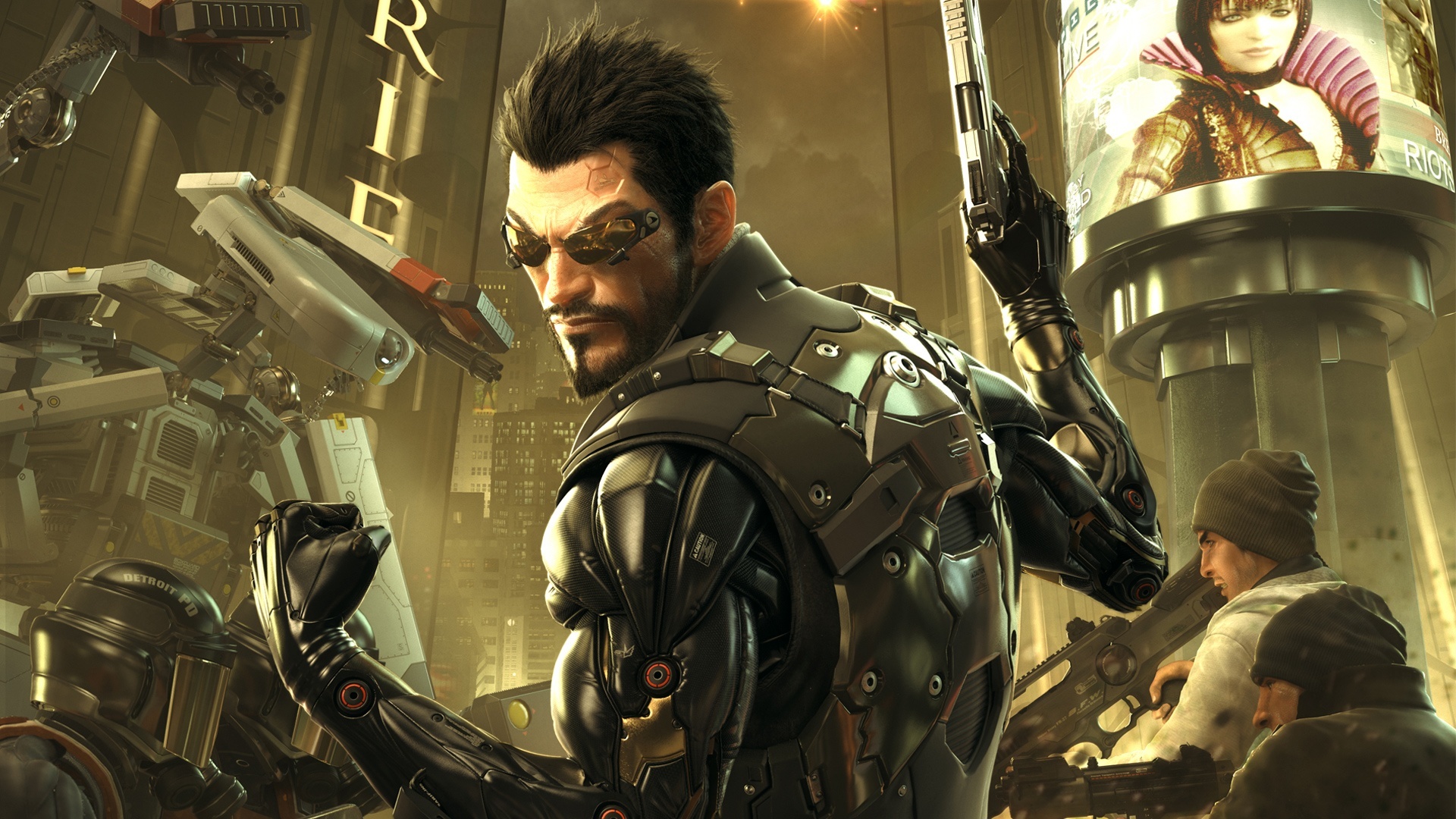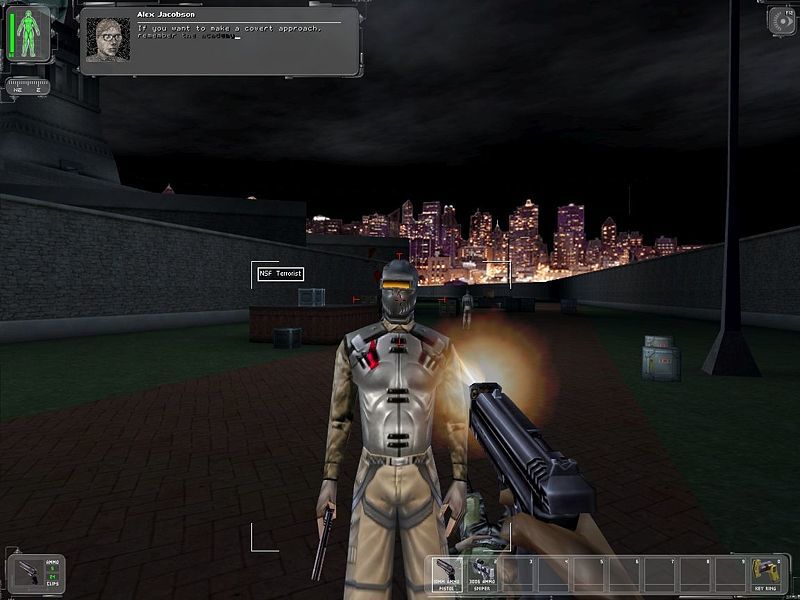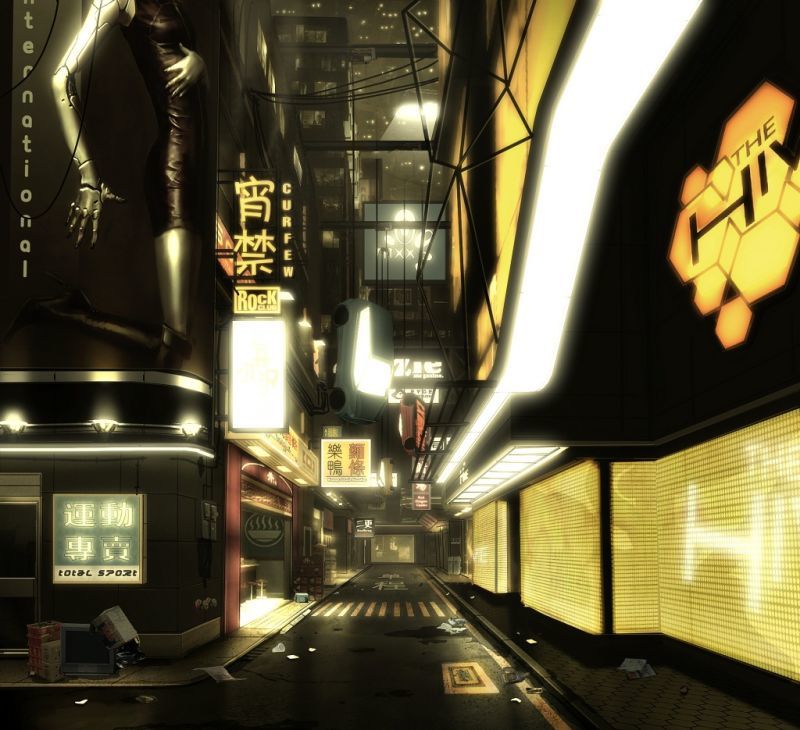Why the future of Deus Ex lies in its past

Having dug up the design materials for the original Deus Ex today, you may be amazed by what Ion Storm has not been able to achieve. In Gamasutra’s post-mortem for the year 2000, designer Warren Spector presented a vision of the game, which actually represents two competing concepts - a mixture of genres that support very specific game styles, compared to the concept of simulation, which has no fixed, previously existing, comprehensive scenarios - just abilities and variables that are under the control of the player. The simulation is so intricate and responsive that it may never have hoped to be created using the technologies of that era.
In his speech, Spector touches upon the genres that influenced the game - shooters, role-playing and plot adventure games.
“But far more important than any genre classification,” he adds, “is that there was a game conceived with the idea that we take players as our employees, returning power to their hands, asking them to make a choice, and then allowing they have to deal with the consequences of these decisions. ”
In other words, the dream is not only to combine several popular approaches with each other, but also to create a game that generally goes beyond categories, but which would be determined by how you play.
The narrative and the setting were surprisingly secondary to this project, at least in the beginning. Deus Ex is perhaps the perfect cyberpunk game, with its dim Blade Runner-inspired lighting, sleek cloaks and a penchant for subcutaneous technology, but according to Spector, Ion Storm settled on the Sci-Fi setting just “to find a place for ourselves to improvise - the real-world setting, as we quickly discovered, was very limited. ” One of the earliest concept papers, known as the “Troubleshooter”, appeared in today's setting and was modeled on the ridiculous images of 80s action actors such as Stephen Seagal - it sounds incredibly blasphemous, considering how greedily the current franchise keepers are comparing with known fashion designers and philosophers.
 Spector sought to minimize the decorative mess in the original Deus Ex, subsequently commenting on the fact that "absolutely every object in the world should serve a purpose." The Human Revolution world treats random details with a more amiable attitude.
Spector sought to minimize the decorative mess in the original Deus Ex, subsequently commenting on the fact that "absolutely every object in the world should serve a purpose." The Human Revolution world treats random details with a more amiable attitude.
It is inevitable that the project’s ambitions dragged it to the bottom during the development process, as the team’s project documentation increased to hundreds of pages, and therefore Ion Storm tried its best to reduce its ideas to what Eidos Interactive could sell. Spector and his colleagues were ultimately forced to squeeze their game into a more rigid, predictable framework, its capabilities were grouped into a number of different branching approaches.
“We simply had neither the time nor the staff to create a sufficiently deep simulation,” he recalled. “We found ourselves in a position where we had to promote the idea of multiple paths, as if the developers of the Ultima series, who, for example, did this for many years, - although I think we have done much more in this regard, we approached it more consciously and more effectively than anyone on that day. Designers had to plan the path of the passage of "skills" bypassing the problems of the paths of "actions" and "interactions with characters". It worked, but it's not what we originally planned. ”
The first Deus Ex is often advertised as the top of a system-driven, open design. But in a sense, his failures were more resilient than his successes. Ultimately, a more rigorous playthrough structure - divided between combat, stealth, burglary (both literally and figuratively, as an intervention in the environment) and social interactions - became the basis of any action-oriented project that prides itself on allowing themselves to "choice and consequences." This robust and flexible pattern can be traced inside such diverse projects as Uncharted, Hitman and Bioshock, but this is an approach whose ubiquity takes the air away from other types of interaction. Indeed, the diversity of the concept of choice was somewhat atrophied in the games of this line. How many times have you heard the producer loudly declare “significant decisions” in the game, and then discover that in practice this means deciding whether to sneak into position or enter it in “fully armed”?
In 2011, enthusiastically evaluated Deus Ex: Human Revolution and last year’s Mankind Divided had the opportunity to pick up the thread that Ion Storm lost - bypassing some of the limitations of the first game, knock out these praised gameplay pillars and get a little closer to Spector's original concept document. But having set the task to revive the problematic brand after the premature demise of Deus Ex: Insurrection and Deus Ex 3, Eidos Montreal decided to double the rate on the basic principles. Speaking at GDC 2012, game designer Francois Lapicas discussed how the studio clarified Ion Storm's achievements in the Human Revolution, rather digging them deep than expanding it - using small semi-open sandbox maps and abilities that were more lively, more pronounced, in contrast to the “very experimental and simulation-oriented” sensation of the original.
 Deus Ex: Human Revolution's Early Concept Art by Richard Dumont
Deus Ex: Human Revolution's Early Concept Art by Richard Dumont
The result was a pair of stunning, action-RPG-rich details that react to your antics in an interesting way - who could forget the fool felting with plumbing fixtures at Sharif's headquarters, and then discover that the alleged terrorists had broken through the base in your absence. But the contribution of Eidos Montreal is also a missed opportunity to develop games that have never been more than the sum of the pieces extracted from such titles as Mass Effect, FEAR, Rainbow 6 and Metal Gear (all mentioned by Lapicas in his presentation at GDC ). Obviously, it is unfair to put a finished project with all its conventions, rough edges, entailing the rejection of a large number of features, opposite the project that never went to the store shelves, but compare and compare the plans of Ios Storm for Deus Ex 3, which should was unobtrusively generating new missions for the player, depending on his behavior. A company of unpredictable variation, compared to the clever, but not enterprising, targeted design of the Human Revolution.
Looking back, we can say that the greatest success of Eidos Montreal is due to the design of the environment and the artistic direction, although this is largely due to the fact that the elegant mixture of rich visual images is a strong amendment to the fragile, socially meaningful, yet desperate mood of the plot. and game script. The cyber-renaissance aesthetics of the game is not just a parallel of a stupid period, connecting the era of biomechanical augmentations with the flourishing of European science and literature in the 15th century — it is a steady development over competing ideologies Prague and Golem City in Mankind Divided.
Here there are swollen, angular, lighted blue, the protrusions of the Palisade Bank - this heart of darkness, where insanely rich people keep their secrets. There are cascading, wavy, gilded dioramas of underground activists, prophets and freedom fighters, rooms in which leather-bound books and cloth rolls fight over space with a pile of monitors and circuit boards. The key to the appeal of these opposing styles and spaces is how they express the way you play. Switching from acrobatic bypass with the help of positional stealth to ongoing battles, your environment alternates between tough, imposing corporate buildings to worn, disheveled splendor of resistance den and black market workshops. Maybe this is the same extensive set as in any other “adult”, “choice-oriented” adventure game, offered since the very first Deus Ex, but the scenery of Mankind Divided, at least, gives the process a special resonance.
 Mankind Divided doesn’t so much attack the legendary dark gold aesthetics of the Human Revolution as it continues, breaking lines and blurring its textures.
Mankind Divided doesn’t so much attack the legendary dark gold aesthetics of the Human Revolution as it continues, breaking lines and blurring its textures.
Admittedly, the artistic direction of the game is not without a share of implicit irony. In Human Revolution and Mankind Divided, Renaissance motifs do not so much create vintage chic as they model ideology when working with landscapes, but there are many supposedly themed scenery elements that look hopelessly contrived - Banksy graffiti, newspaper headlines “Aug Lives Matter” that are awkward bind the oppressed cyborgs in a game with victims of real oppression. But this fascinating portrait of the late capitalist society falls into a self-ruined hole, as it is confined to the framework of the game mechanics, who by default offer either shooting or hidden passage.
The future of the series is again in question. Eurogamer reported earlier this week that Square Enix has currently put off Deus Ex due to weak Mankind Divided sales. Apparently now Eidos Montreal is helping Crystal Dynamics with the next Tomb Raider, and also working on the first game in the Marvel universe. This is probably the best time for a break, but I hope that the developers will eventually return to this universe - because, being a pioneer, Deus Ex, like its brilliant implementation led by Eidos Montreal, proved that the old concept of Warren Spector hides a glimpse of something more grand.
')
Source: https://habr.com/ru/post/403149/
All Articles